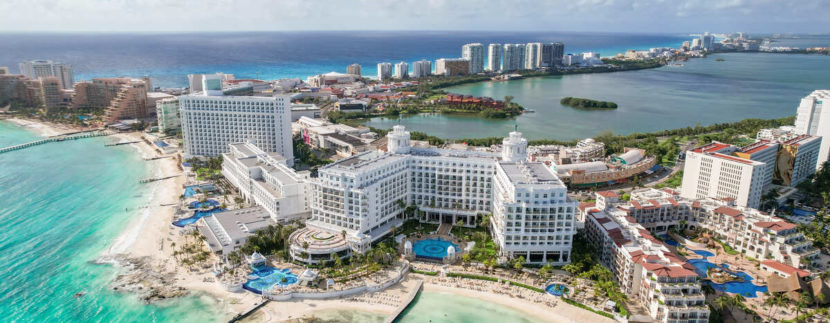Expert Confirms American Tourists Do Not Face Higher Risk In Mexico Than At Home

[ad_1]
Last Updated
Once again, Mexico has come under the scrutiny of the media following the kidnapping and murder of Americans in a non-touristic border town.
This has prompted U.S. authorities to issue new travel alerts, with the state of Texas going as far as warning citizens against travel to Mexico as a whole.

While it’s true that crime can occur in Mexico, like anywhere else, every single one of its major tourist destinations remains under heavy surveillance and under the protection of law enforcers. Still, detractors have been relentless in their mission to trash Mexico’s reputation as a safe spot.
But they might be running out of ammunition, as a high-profile security expert weighs in and confirms Americans do not face higher risks in Mexico than at home:
How Safe Is Mexico?

Mexico has been at the center of attention since the Matamoros murders when four U.S. citizens crossed the border via land and ended up being kidnapped. Two were murdered, prompting a passionate backlash from a number of U.S. congresspeople, particularly on the Republican side, who called for tougher interventions against violence.
However unfortunate and an unspeakable tragedy, the Matamoros incident is far from reflecting levels of security across Mexico as a whole. As a matter of fact, the presence of the National Guard, municipal officers, and other anti-crime entities across tourist sites is widespread.
Top 5 Travel Insurance Plans For 2023 Starting At $10 Per Week

Recently, Tulum authorities announced a new ambitious operation to reduce crime significantly within 100 days, and the Mexican President himself came out in his own’s country defense by reminding tourists that one of the Government’s priorities is to keep them safe.
He went as far as stating Mexico is ‘safer’ than the United States and that violent crimes, such as the horrifying events that took place in Matamoros, are very much an exception rather than the rule. The media frenzy continued, nonetheless, as did the anti-Mexico rhetoric online.

Now, a security expert has shared his thoughts on the matter, and he seems to have sided with supporters of Mexico on this one.
Experts Weigh In
So is Mexico dangerous? According to Nick Phillips Jones, the Director of Investigations and Intelligence at the Sargasso Group, a Mexico-based intelligence firm, it depends on where you are in the country, in which circumstances, as well as several other factors.

Mr. Jones reminds Americans that ‘where you go, how you get there, where you stay‘, and even more pressingly, your decisions, must be taken into account when assessing safety risks.
In Mexico’s case, the vast majority of crimes occur in suburban areas that are not usually frequented by foreigners.
Hence, when a U.S. citizen who stands out in a Mexican crowd wanders off the main path, especially in run-down areas, there is a higher chance that they could become targets.
Jones notes that, in many ways, ‘the story stays the same’: no-go zones should be avoided at all costs.

In Mexico, this means steering clear of border areas where organized crime activity is rampant, and checking the latest travel advisories issued by the Department of State, though in reality, ‘the vast majority of tourists who come to Mexico from the U.S. and elsewhere‘ do not face higher risks than in their home country.
That is, as long as they stick to the ‘beaten track’. Out of 32 states that form the Federation of Mexico, only six are listed by the U.S. as very dangerous. A further seven have significant risk levels to warrant a ‘Reconsider Travel’ warning, including Jalisco, where the hugely-popular Puerto Vallarta is located.

Despite the wording, experts advise travelers to take travel advisories with a grain of salt, as they do not always accurately reflect the situation on the ground.
Harding Bush, Senior Manager of Security Operators at Global Rescue, is quoted saying, ‘don’t just look at State Department warnings and advisories‘.
Look Beyond Official Travel Warnings
He argues Mexico has one of the largest territorial expanses in the Americas, on top of being the 13th largest sovereign state in the world.
To put it simply, even a single Mexican state can be the size of a whole country, and travel alerts applying to entire states are definitely not representative of all municipalities within an administrative region.

‘It’s important to understand the situation in the specific locality you are heading to‘, added Bush. ‘Look at the news, the U.S. news, and the news in Mexico. Talk to people who have been there before‘.
Bush cites the U.K. Government website as a reliable source for up-to-date travel updates, as British authorities give more detailed information regarding safety concerns and potential risks involved with traveling to Mexico.

The expert conceded there’s been an increase in gang activity in places like Cancun, Tulum, and Playa del Carmen as a result of illicit drug consumption, often practiced by tourists. Naturally, the drug and rave subculture in the Mayan Riviera has fuelled a rise in crime.
Even then, resort areas are extremely well-guarded, and gang members know better than to attack Americans and ruin Mexico’s hard-earned gains in the tourism sector. Gun violence is almost exclusively limited to territorial disputes between different gangs, or turf wars.
Tourists Are Not A Target

Regarding the Matamoros murders, the Gulf cartel issued a formal apology and reaffirmed harming, or targeting tourists is not their intention.
The men responsible for the atrocities were handed over, and as Jones put it, this shows ‘how keen they are to avoid and deflect the wrath of the U.S. law enforcement‘.
Back to Bush, he concludes that ‘there’s a lot of crime in Mexico’, but it doesn’t necessarily target tourists. Unless they find themselves ‘in the wrong place at the wrong time’. This is easily avoided:

- Do not stay outside tourist zones or explore off-path neighborhoods, especially in peripheral districts, by yourself
- Contact your hotel concierge about reliable companies offering guided tours and private transfers
- When crossing the border via land, preferably do so during the day, and in popular crossing points
- Make sure you don’t flash valuables walking in public areas
- Be careful withdrawing cash from ATMs (always ensure there is no one observing you)
Compared to other Latin American nations, Mexico is very safe – but of course, some level of caution is still needed.
Traveler Alert: Don’t Forget Travel Insurance For Your Next Trip!
↓ Join Our Community ↓
The Travel Off Path Community FB group has all the latest reopening news, conversations, and Q&A’s happening daily!

SUBSCRIBE TO OUR LATEST POSTS
Enter your email address to subscribe to Travel Off Path’s latest breaking travel news, straight to your inbox
This article originally appeared on TravelOffPath.com
[ad_2]
Source link






